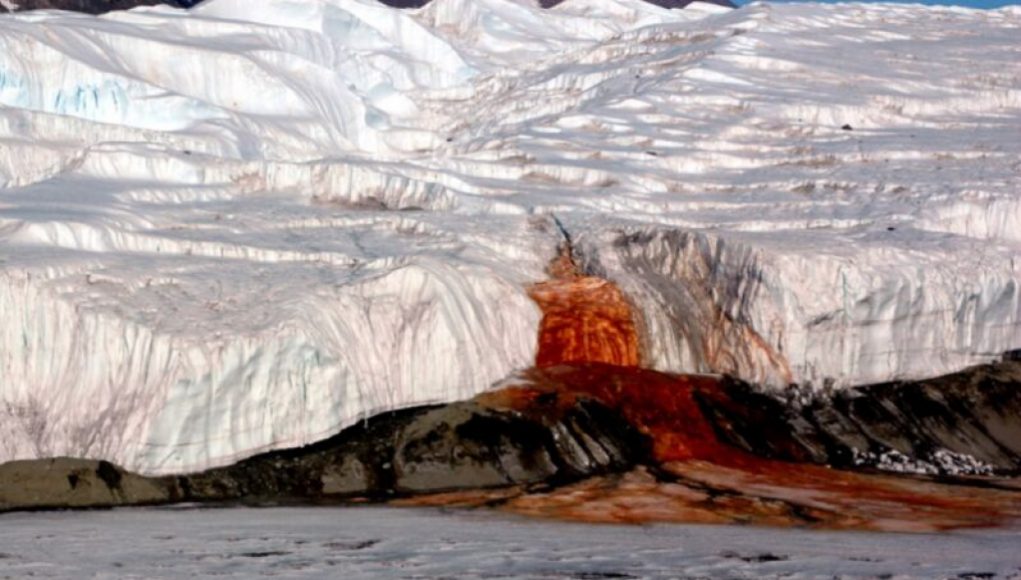In 1911, an Australian geologist named Thomas Griffith Taylor made a remarkable discovery while exploring a valley in Antarctica. He stumbled upon a mesmerizing waterfall that defied explanation. The meltwater flowing from beneath the glacier, now known as Taylor Glacier, turns a deep red upon contact with the air, earning the name “Blood Falls.” For over a century, scientists have been puzzled by this phenomenon, proposing various hypotheses. Finally, a team of researchers believes they have found the answer: tiny nanospheres containing iron, silica, calcium, aluminum, and sodium, among other elements.
But why has it taken more than a century to solve this mystery? The nanospheres are amorphous materials, lacking a crystalline structure, which made them elusive to previous analytical methods focused on minerals. In a recent paper published in the journal Frontiers in Astronomy and Space Science, the researchers explain that the Blood Falls at Taylor Glacier serves as an “analogue” site for astrobiologists and planetary scientists. They study this site to gain insights into how life might evolve and thrive in similar inhospitable environments elsewhere in the universe.
“With the Mars Rover missions, there was a curiosity about analyzing the solids from the waters of Blood Falls as if it were a Martian landing site,” said co-author Ken Livi of Johns Hopkins University. “What would happen if a Mars Rover landed in Antarctica? Could it determine the cause of the red color in Blood Falls? It’s a fascinating question that several researchers were exploring.”
Advertisement
Among those researchers is co-author Jill Mikucki, a microbiologist from the University of Tennessee. She has dedicated years to studying the Taylor Glacier and its unique waterfall. Mikucki and her team previously used techniques employed by NASA for its Mars missions to examine samples taken from the site. These techniques include Mossbauer spectroscopy, visible to near-infrared spectroscopy (VNIR), mid-far infrared spectroscopy, in situ x-ray diffraction (XRD), and Raman spectroscopy.
In 2009, Mikucki’s team made a groundbreaking discovery. They detected living organisms, specifically 17 different types of microbes, in the lake beneath the glacier. These organisms are capable of surviving in the dark, oxygen-free waters by deriving energy from sulfur and iron. In 2014, using a special probe called IceMole, the team directly sampled the salty water flowing into the Blood Falls. Through extensive mapping of glaciers, caves, and rivers, Mikucki’s team determined that the water originates from a briny subglacial reservoir rich in minerals. These minerals accumulate in the ice as it moves across the rocks. The researchers also found that the brine is very cold, with a temperature of minus 7° Celsius (19° F), and contains 8 percent sodium chloride. Additionally, they isolated a bacteria that thrives in the cold, anaerobic environment and two other types of bacteria.
An enigma that has puzzled the scientific community for a century may finally have been resolved by researchers from the University of Alaska Fairbanks and Colorado State University. The discovery, published earlier this week in the journal Nature Communications, solved the mystery of Antarctica’s “Blood Falls.”
The so-called Blood Falls, located in Taylor Valley in Antarctica, were discovered more than a hundred years ago by the Australian geologist Griffith Taylor. The strangely colored waterfall, a rusty red that looks like it is seeping out from behind the wall of ice, has been puzzling researchers ever since.
Using radar images and a series of drills into the glacier covering the falls, the research team has discovered an iron-rich saltwater lake trapped beneath a 1,300-foot-thick layer of ice. The lake has been isolated from the sea for the past two million years and is believed to be the source of the strange red hue of the falls.
The saltwater lake is at least five times saltier than the sea and appears to be the result of evaporation of sub-glacial seawater. Researchers believe the evaporation created an environment with high salinity, allowing a unique microbial community to form and eventually allowing iron to accumulate in the brine at an unprecedented rate.
The presence of the iron then causes the distinct reddish color of the water, as it’s exposed to oxygenated air when it comes out from the falls. The lake also appears to be the source of the 10 to 30 millimeters of icy brine that drip from Blood Falls every day.
The discovery of the lake is a remarkable breakthrough that has shed light on the mystery of Blood Falls and may help researchers to better understand how the Antarctic environment has changed over time. It is also a testament to the importance of science, as it took researchers a century of questioning and research to finally unravel the story behind the mysterious falls.




















